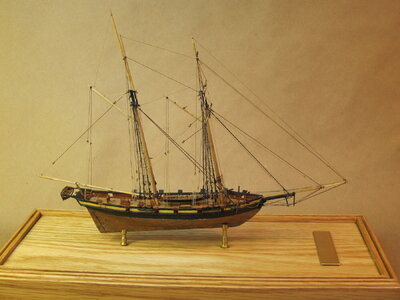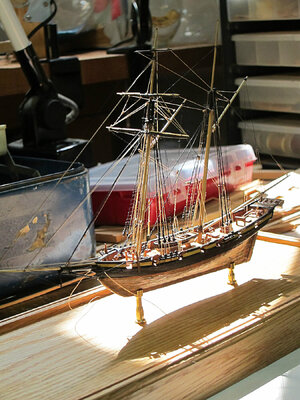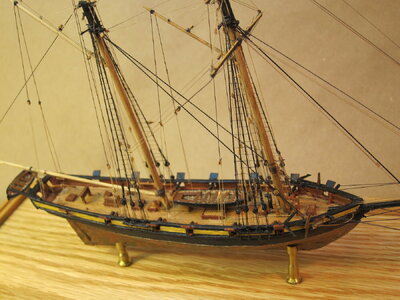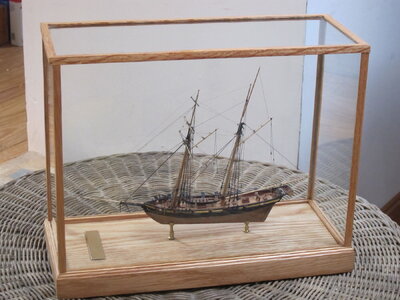- Joined
- Mar 22, 2019
- Messages
- 39
- Points
- 78


Looking for a portable project to fill in down time when still working, I selected the 1812 privateer Lynx as a suitable subject. At the time, I still believed almost anything was possible at 1/192, so the 6” hull was easily tossed into a briefcase or messenger bag with a few tools. The plans were taken right from Chapelle’s Search for Speed Under Sail and xerographically reduced, or increased, for the sail plan, to the correct scale. Templates were cut out on commuter bus or train rides. Once the hull blank was glued up, it traveled easily. Much of this was before 2001 and the difficulty of explaining some of the tools at airport security checkpoints wasn’t an issue yet. The basic carving got done at a hotel in Newport
 . Much of the finer shaping was done in another hotel in Las Vegas. Deck planking went on in between administering off site seminars.
. Much of the finer shaping was done in another hotel in Las Vegas. Deck planking went on in between administering off site seminars.Things started to become more difficult as the model progressed. At a resort in Mexico, I made a mistake in the bulwarks that had to be later corrected. During a trip to a cabin in Maine I accepted I had done more harm to the model than good. Her traveling days were over. Afterwards, progress was limited to whatever time could be managed in the workshop at home.
This schooner was chosen for a few reasons. I wanted to become more familiar with topsail schooners in general. Having made mostly waterline models up to this point, I also wanted more experience shaping a full hull, and Lynx’s basic hull seemed a good place to start. There is no doubt this privateer makes an attractive model of a distinct vessel type. It is surprising there have not been more models made of her, although there are several kits of similar types, and Armitage McCann’s “Swallow” (Popular Science Nov. – Feb. 1934-35) is also very similar.

This Lynx is scratch built. Few would see the opportunities at this scale I imagined when I started the model. It is made almost entirely of pine, for the lifts, deck planks, bulwarks, and most of the deck furniture. Boxwood was necessary for a few smaller pieces, but especially for the rigging blocks and my attempt at the hatch gratings. The boats are carved out of pine and given frames, seats, and floorboards of painted paper. Masts and spars are bamboo and the mast hoops are copper wire hammered flat and bent into hoops. The cannons are 1/16” brass tubing turned on a small Sherline lathe. The deadeyes are the exception. These are 1/16” bakelite, purchased from Bliss Marine years ago. They are oversize. 3/64” would have probably been more accurate, but I have never seen any commercially made deadeyes available that small. Crazy as I was to make the rigging blocks as small as they are, I was not about to attempt making the deadeyes. Originally, I estimated 87 blocks would be needed, but eventually made 240. Of these, 58 were left when the schooner was done. Some were lost when they sprang off the tweezers and vanished, but the bigger drain was blocks too poorly made to be stropped or used. The technique for making these blocks is simple, but it takes practice to made good ones.

The case is of oak and was difficult for me. Most of my models have gone into bottles, which only require a stand to keep them from rolling away. So, I have had little experience with cases and this took quite a while to accomplish and without the level of accuracy that might be desired. The brass pedestals were also turned on the Sherline lathe, and whole business does keep the dust off.

I took some liberties with this model. Chapelle has the jibboom set on the bowsprit a few feet outboard of the stem and has the flying jibboom arched down, presumably drawn down by the tension on the stay through the martingale. This seemed excessive, with the tip of this fragile spar only a few feet above the water. I set the jibboom right up against the stem, reducing the outboard reach of all the head rigging. I think the resulting rig would still have been an adventure to sail. I also coppered her lower hull with paper strips painted with acrylics. Lynx may have been coppered, but probably not until after her capture by the British. Then, as HMS Mosquitobit, her armament was changed from long guns to carronades. I stayed with long guns and increased the armament from the six 12 pounders noted in Chapelle to ten smaller guns. These were all done for my personal satisfaction, and that was the essential goal of the project. In this, Lynx has mostly succeeded.
